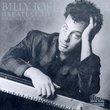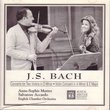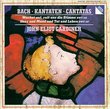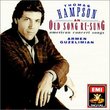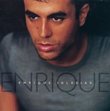| All Artists: Franz Joseph Haydn, Jenö Jandó Title: Haydn: Piano Sonatas Vol. 6, Nos. 20 and 30-32 Members Wishing: 0 Total Copies: 0 Label: Naxos Release Date: 5/13/1997 Genre: Classical Styles: Forms & Genres, Sonatas, Historical Periods, Classical (c.1770-1830) Number of Discs: 1 SwapaCD Credits: 1 UPC: 730099436427 |
Search - Franz Joseph Haydn, Jenö Jandó :: Haydn: Piano Sonatas Vol. 6, Nos. 20 and 30-32
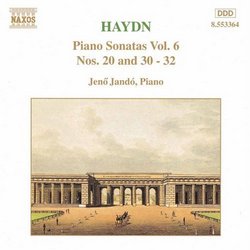 | Franz Joseph Haydn, Jenö Jandó Haydn: Piano Sonatas Vol. 6, Nos. 20 and 30-32 Genre: Classical
|
Larger Image |
CD DetailsSimilar CDs
Similarly Requested CDs
|
CD ReviewsLovely interpretation of Haydn's Sonatas David Keppel | 06/04/2001 (5 out of 5 stars) "It has been said that Mozart wrote his piano sonatas for his students and kept his concertos for himself. This is meant to imply he simply "tossed off" the simple sonatas meant to be used as learning material with little care as to their quality. Haydn presumeably did not share this feeling for his many piano sonatas often surpass Mozart's. Jeno Jando has played works by many many composers and certainly his interpretations of all of them are not going to be ideal. But his playing on this record is lovely with just the right touch. I would recommend you pick up all the cd's in this set of Haydn's piano sonatas. Being on the Naxos label they are priced rediculously low. All the better for us." Classic and passionate David Keppel | Bloomington, IN United States | 09/21/2006 (5 out of 5 stars) "The A Flat Major and D Major sonatas here are an exquisite and moving expression of Haydn's passionate classicism, where development is everything. Jando's performance is superb. These are among my favorite recordings of anything." Exploring the Haydn Sonatas -- Nos. 20,30,31,32 Robin Friedman | Washington, D.C. United States | 08/10/2009 (5 out of 5 stars) "In celebration of the 200th anniversary of Haydn's (1732 - 1809)death, Naxos has released a ten-CD compilation of Jeno Jando's recording of the complete Haydn piano sonatas. These individual CDs were originally released in the mid-1990s, and they remain available separate from the box set. I have been enjoying listening to each volume of Jando's Haydn and sharing my thoughts about the sonatas here on Amazon. The CD I am discussing here is the fourth in chronological order in the cycle and includes four lovely sonatas.
The numbering of Haydn's sonatas tends to be confusing, but the four sonatas on this CD are relatively early works dating from the 1766-1768. Haydn originally composed these works for the harpsichord. In playing this sort of music on the piano, it is important to make use of the resources of the latter instrument in terms of dynamics and tone quality rather than to perform as though the instrument were a harpsichord. Jando gives a pianistic yet idiomatic reading of these works with control of dynamics, thoughtful articulation, and a sparing but effective use of the pedal. Jando sometimes hums during these performances, but I did not find this mannerism distracting. For early works, these sonatas capture a variety of styles and moods. The most impressive work on this CD is the three-movement sonata no. 31 Hob 46 in A flat major, probably dating to 1768. This piece is large-scaled, ambitious and expansive while yet conveying a sense of intimacy. Haydn tended to work with short themes and to vary and expand upon them.. Thus the opening movement of this work, allegro moderato, features two contrasting thematic groups, both of which consist of short phrases broadened and varied. The movement is full of embellishments together with many shifts in tempo, rhythm and figuration. Haydn also makes large use of counterpoint with the hands frequently echoing each other and carrying different themes. The second movement adagio contrasts with the large structure of the opening movement. It begins with a plaintive theme stated by the left hand alone. The right hand soon joins in what becomes a two-voice duet. The movement expands into flowing, broadly-voiced lyricism before a return of the initial material together with a large cadenza. The short finale is lively and virtuosic with both lengthy running passages and large octave accompaniments. This is a challenging and fascinating sonata. Haydn's ventures into minor key compositions are always worth knowing. The two-movement sonata no. 32 in G minor, Hob 44, is one of his earliest piano sonatas in the minor. It was probably composed before 1770. This work does not have the tragic or the angry character frequently associated with minor key compositions, but it does have poignancy and considerable passion. The work opens with a moderato in which the prevalent minor key theme is contrasted with a more cheerful secondary theme in falling arpeggios. The dark character of the movement predominates during a passionate development section. In the second movement, allegretto, Haydn again opens in a minor mode, with contrasting thematic material in G major. In this movement, the major key wins out as the work comes to a lyrical, peaceful conclusion. The three-movement sonata no. 30 in D major, Hob. 19, dates to 1767. The work opens with a moderato movement featuring a characteristically Haydn theme in dotted notes. The movement has a jagged, bumptious character with an expansive development, long passages in triplets, and the frequent use of repeated notes. The second movement is a reflective and expressive andante in two parts. It contrasts with the vigor of the opening movement. The finale is a short whirlwind allegro assai in short sections which vary the initial theme of the movement. It brings this sonata to an irrepressibly catchy close. The short two-movement sonata no. 20 in B flat major is the earliest on this CD, dating from 1766-1767. The opening allegro moderato features two contrasting themes of which the second theme, with its lilting, swinging character is the more memorable. The work concludes with a moderato which likewise features a secondary theme based on lovely descending thirds, together with passages in octaves, and long, lacy runs. Robin Friedman" |

 Track Listings (10) - Disc #1
Track Listings (10) - Disc #1


